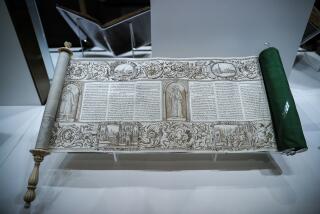Author ‘Links’ Moses and Lenin : Political Philosopher Poses a Provocative Theory
- Share via
Moses and Lenin had a lot in common.
In fact, a case can be made that the Old Testament patriarch, law-giver and rescuer of the Israelites from Egypt was the prototypical revolutionary.
This provocative idea comes from political philosopher Michael Walzer, who sees in the story of Exodus parallels with today’s liberation struggles. But he also sees Exodus as a supermarket of events and ideas that can and has been used to supply many modern political persuasions.
Walzer, a professor of social science at the Institute for Advanced Study in Princeton, N.J., was in Los Angeles recently to elaborate on this topic, which he also explores at greater length in his new book “Exodus and Revolution” (Basic Books, $15.95). His appearance here was to deliver the Jerome Nemer Lecture at USC.
Walzer, whose other books include “The Revolution of the Saints” and “Just and Unjust Wars,” maintained that the biblical account of the Israelites’ escape from bondage and the long journey to the Promised Land is a seminal political document. It has enduring value both as propaganda and inspiration, he said. The Book of Exodus has been cited by St. Augustine, Thomas Aquinas, Machiavelli, John Knox, Hegel, Marx, Lincoln Steffens and liberation theologians in Latin America--among others--to support policies or score debating points, Walzer said.
“One might usefully divide theorists of revolution and writers about the Exodus into two groups,” he said. There are “those who believe that the liberation of the oppressed will always be . . . a gift of God, or of history, or of the vanguard and those who believe, to some degree at least, it must be the work of the oppressed themselves.”
As a political alibi, Exodus appeals because the story of the flight from Egypt and the wandering in the desert is deeply embedded in western culture, he added.
A ‘Crucial Influence’
As such, “ . . . the biblical account of the deliverance from Egypt is the crucial influence on and the crucial model for the idea of revolution as it has appeared in western political thought,” Walzer declared.
In bare outline, the story of Lenin, who lived much of his life in exile, can be made to seem much like that of Moses, who fled Egypt after killing an Egyptian, Walzer said. Both are about “a slavish people incapable of liberating themselves, incapable by themselves of imagining what liberation might be like, the revolutionary leader who comes from the outside, whose life experience is entirely different from that of the oppressed men and women he leads, the band of militants recruited from among the people but also separated from them, who form an organized and disciplined cadre and, finally, the constant purging of the people by the militants,” he said.
First Counterrevolution
The crucial text in Exodus, Walzer said, is Chapter 32 in which Moses calls on the Levites to use their swords against their own people. They slay about 3,000 men. Moses issues the order after coming down from Mt. Sinai with the 10 Commandments, only to find the tribes worshipping a golden calf. This longing by the Israelites to return to the habits of Egypt might be called the first counterrevolution. And the slaughter might be called the first revolutionary purge, Walzer contended. Indeed, the episode illustrates a basic political problem--”When can the sword rightly be used and by whom can it rightly be used.”
But the interpretation that casts favorable light on stern measures in modern revolutions is not the only one, Walzer said.
“If there is a Leninist reading, as I have suggested, there is also a social democratic reading that stresses the indirection of the march and the role of Moses as a pedagogue of the people . . . and deemphasizes the story of the golden calf,” he said. In this light Moses is a reasonable man as well as an angry, vengeful one, who is “portrayed as arguing with people again and again. . . . He is rather more successful with God than the people.”
Walzer added, “The text can be read either way and that’s why it has been read so long and so hard. Over the years it has more frequently been used by those who want to imitate the Levites at Mt. Sinai and coerce and kill their enemies in the revolutionary cause. Such people have greater need of historical or religious justification.”
From Bondage to Freedom
However, the reading of Exodus supported by Walzer is that “the people can move only in gradual stages from bondage to freedom.”
And for hundreds of years, Exodus has been a comforting example, when people must face the transition from slavery to freedom, Walzer said.
“Physically, the escape from Egypt is sudden, glorious, complete,” he explained. “Spiritually and politically, it is very slow, a matter of two steps forward, one step back. . . . A newly freed slave in 1862, writing to his fellows, provides a nice example. He says, ‘There must be no looking to Egypt. Israel passed 40 years in the Wilderness. What if we cannot see right off the green fields of Canaan? Moses could not either. We must snap the chains of Satan and educate ourselves and our children.’ And, similarly, a Latin American priest writing in the 1960s describes the wilderness period as a time of hardship and struggle, ‘a gradual pedagogy of successes and failures in the course of the long march.’ ”
More to Read
Sign up for our Book Club newsletter
Get the latest news, events and more from the Los Angeles Times Book Club, and help us get L.A. reading and talking.
You may occasionally receive promotional content from the Los Angeles Times.










